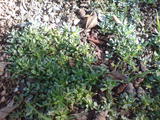860810 Antennaria alpina (L.) Gaertn.
- Gaertn., Fruct. Sem. Pl. 2, 3: 410 (1791). - Gnaphalium alpinum L., Sp. Pl.: 856 (1753). Lectotype (LINN): Sweden. Herb. Linn. 989.71 (Malte 1934: 102, pl. 281). See notes.
- ?Antennaria alpina var. ungavensis Fernald, Rhodora 18: 238 (1916). Holotype (GH): Canada: Labrador, Ungava, Stillwater River, 12. Aug. 1896, leg. Spreadborough, Geol. Surv. Can. 44,442. - ?Antennaria ungavensis (Fernald) Malte, Rhodora 36: 110 (1934).
- ?Antennaria arenicola Malte, Rhodora 36: 110 (1934). Holotype (CAN): Canada: Quebec, east coast of Hudson Bay, Port Harrison, 5817'N, 7810'W, 18-20. Aug. 1928, leg. Malte 120,714.
2n=
For the collective species: 56 63 70 76 84 98 112 ca. 120 (8x-17x). - North America (W). - Chuksanova et al. (1968); Chinnappa (1986); Chmielewski and Chinnappa (1988).
Acceptance of these numbers depends on how the species is circumscribed.
Geography: Amphi-Beringian? - North American (N) - amphi-Atlantic - European (N).
Notes: Linnaeus (1753) described Gnaphalium alpinum (= Antennaria alpina) with "Habitat in Alpibus Lapponiæ, Helvetiæ". The species does not occur in the Alps and the selected lectotype is certainly from northern Sweden.
Elven and Solstad: The concept of Antennaria alpina has been much disputed, and still is. The European opinion is that A. alpina s. str. is restricted to northwestern Europe where it is common in the Scandes northeastwards from southwestern Norway and slightly into the Russian Murman area (e.g., Hultén 1971a; Hultén & Fries 1986). Hultén had much experience (also in the field) with both the Fennoscandian and the North American plants. He considered A. alpina replaced by A. canescens (A. boecherana) in Iceland, Greenland, and the northeastern and northern parts of North America. This view was reflected for Europe by Halliday (1976b). We compared Icelandic and Scandinavian plants in 2010 and regard them as different, eiter at specific or at subspecific level. In addition, Halliday (1976b) and we accept A. porsildii as an amphi-Atlantic taxon in the group. Hultén's and Halliday's view is still the prevalent one among northern European authors (e.g., Mossberg et al. 1992; Elven et al. 2005). However, it should be noted that A. alpina is confined to the northwestern margin of Europe, almost entirely covered by the Pleistocene glaciations, without close relatives (except for "porsildii") elsewhere in mainland Europe or northwestern Asia, and therefore most probably with a not very old North American and/or Greenlandic connection and origin.
The current North American opinion differs from the European one. North American authors regard A. alpina as one of the major northern and arctic species or complexes of the genus in Greenland, northern Canada, and Alaska (Bayer 1993, 1996, 2006; Chmielewski 1998). About 20 species names have been applied in the last 20-30 years for more or less arctic plants stated to belong to an A. alpina group, the majority in North America and Greenland. Bayer (in several papers up to 2006) treated what he named A. alpina s. lat. more collectively than he treated the aggregates of A. friesiana s. lat. and A. monocephala s. lat., perhaps because A. alpina has parts of its range outside North America and Beringia and because the type is European. Bayer (1993: 154) stated that: "It is likely that infraspecific categories will be recognized to describe major subspecific groups in A. alpina, similar to what has been done for the other large polyploid complexes ...". Bayer (2006) stated, more specifically, that "the primary sexual progenitors of the A. alpina complex include A. aromatica, A. densifolia, A. friesiana ssp. alaskana, A. friesiana ssp. neoalaskana, A. monocephala ssp. monocephala, and A. pallida". As such, it could be treated in a similar way as the A. rosea complex, as a polyploid collective species (reticulum) with subspecies, if such ones could be identified. The problems are discussed by Bayer (2006: 414-415).
Bayer's (1993) suggestion was followed by Chmielewski (1998) who lumped a large number of named North American species into three subspecies of A. alpina. We are not convinced that two of the subspecies should be as inclusive as they are by Chmielewski. Our European opinion may have been influenced by being familiar with Linnaean A. alpina. We therefore easily see something different in many of the North American and Greenland taxa included in it. Bayer (2006) did not refer to or take Chmielewski's (1998) treatment into account, which makes comparison and evaluation difficult.
We somewhat reluctantly follow Chmielewski's circumscription of A. alpina s. lat., and also his division into three subspecies, but we regard subsp. alpina as European, subsp. porsildii as amphi-Atlantic, and subsp. canescens as broadly American and Greenlandic plus Icelandic. We transfer two of the names of plants that reach the Arctic from subsp. alpina to the species: A. arenicola and A. ungavensis. One named species is unassigned (A. crymophila) and is entered provisionally. The two names in synonymy represent North American plants that Chmielewski (1998) considered part of subsp. alpina. Antennaria ungavensis has a disjunct range with a main area in Ungava and Labrador and extends to the west coast of Hudson Bay, and then with a strange locality group reported from the Rockies in Alberta. The Rocky Mountains plants differ much from the Scandinavian plants, at least morphologically. Antennaria arenicola is another northeastern North American name with type from Hudson Bay. If subsp. alpina is European, as we believe, these names may belong in the synonymy of subsp. canescens.
Higher Taxa
- Antennaria [8608,genus]
